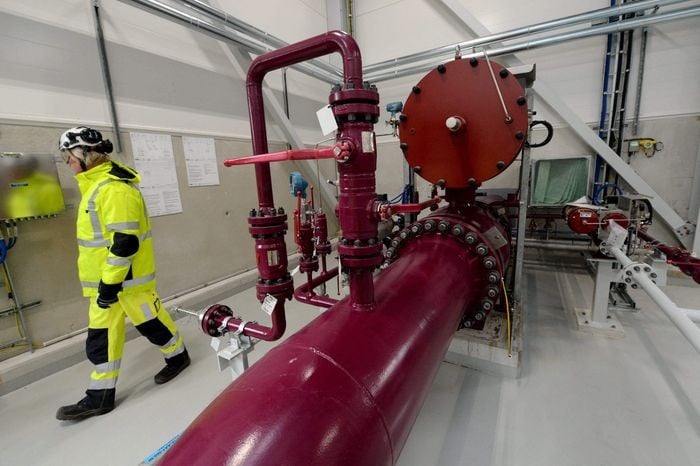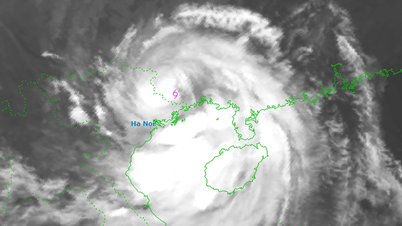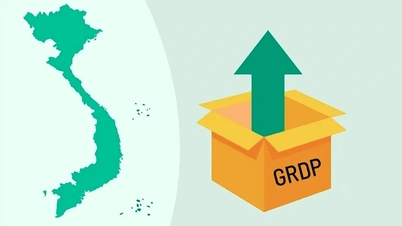 |
| After more than a year of hardship, many believe that the energy crisis in Europe is over. Photo: A compressor station of the Balticconnector gas pipeline in Inga, Inkoo, Finland. (Source: Getty Images) |
In an article published on November 28, market analyst of Reuters news agency (UK) John Kemp affirmed that the energy crisis in Europe is over.
According to the article, from mid-2021 to the end of 2022, Europe and some regions in Asia fell into an energy crisis as oil, gas, coal and electricity prices rose, even reaching record highs at times. This reality forced households and businesses to quickly cut their usage.
Russia's launch of a special military operation in Ukraine (from February 2022) and sanctions imposed by the US and its allies in retaliation against Moscow have disrupted energy supplies that were already stretched by the recovery of industrial production after the Covid-19 pandemic.
But 18-24 months later, the sharp correction is complete, with energy inventories at comfortable levels and prices returning to their multi-year (inflation-adjusted) averages.
There will certainly be more shocks in the future, but the energy disruptions associated with the end of the pandemic and the Russia-Ukraine conflict are over. The market has adapted.
Europe’s remaining problem is that it has substituted relatively cheap Russian pipeline gas for expensive liquefied natural gas (LNG), putting the continent’s industrial competitiveness at risk. But that is a chronic problem, not a crisis.
Abundant oil supply
In the oil market, US crude oil production continues to rise and will surpass its pre-pandemic peak in August 2023. Production sources other than the Organization of the Petroleum Exporting Countries (OPEC) are also growing steadily.
US data showed that commercial crude oil inventories were 12 million barrels above the 10-year seasonal average in mid-November, a sign of ample supply.
Brent crude oil prices have averaged $82 a barrel since the start of November, on par with the average since the turn of the century after adjusting for inflation.
By late 2022 and early 2023, concerns about overproduction and the potential for oil inventories to run out have replaced concerns about insufficient supply and rapidly depleting reserves.
In response, Saudi Arabia and its OPEC+ partners have cut output multiple times to prevent inventories from rising, in stark contrast to the pressure on them a year ago to boost output to address an expected shortage.
Gas prices fall
The rapid adjustment is also evident in the gas sector, where US inventories have been above the 10-year seasonal average since February 2023 and exports have surged to record levels.
US natural gas futures last month traded near a 30-year low, adjusted for inflation, confirming the market is reacting to a supply glut.
In Europe, gas stocks have been at seasonal record levels since the end of Q1/2023 following an unusually warm winter in 2022/23 and a sharp decline in industrial gas consumption.
Output from Germany's energy-intensive industries has fallen by around 17% since the start of 2022 and shows no signs of recovery.
Total gas use in the European Union's (EU) top seven consuming countries, including Germany, Italy, France, the Netherlands, Spain, Belgium and Poland, fell by 13% in the first nine months of 2023 compared to the 10-year average (2012-2021), the period before the Russia-Ukraine conflict broke out.
Inflation-adjusted future prices for next year will average 48 euros per megawatt hour by November 2023, down from 223 euros at the peak of the crisis in August 2022.
In fact, the average price is 53 euros for 2023 compared to 23 euros in the five years from 2015-2019 and 32 euros from 2010-2014. Although prices are still high, they are no longer at crisis levels and are likely to fall further in 2024.
Coal demand drops sharply
An even deeper correction has occurred for coal, with demand falling sharply as gas supplies became more abundant while mining output surged.
Realised prices for coal delivered to Northwest Europe next year are expected to average just $112/tonne in November 2023 from a record close to $300/tonne in September 2022.
On the production side, China - the world's largest coal mining country, increased output by 425 million tonnes (10%) in 2022 and by 144 million tonnes (4%) in the first 10 months of 2023.
Flexible adjustment
Each market has gone through a different adjustment process, but what they all have in common is faster production growth and slower consumption growth.
On the oil front, consumption is growing more slowly due to a slowing business cycle, while production in non-OPEC+ countries is rising faster, pushing the market towards surplus. Russian exports remain high despite US and Western sanctions.
On gas, Europe experienced an unusually warm winter in 2022/23 that cut consumption and also saw a big drop in industrial demand from the biggest energy users as factories shut down.
The continent has been able to replace pipeline gas from Russia with more LNG imports, outpaying other customers in South and East Asia in the 2022/23 winter season. This has placed some of the adjustment burden on poorer countries.
On coal, China's growing output coupled with the exponential rise of renewable energy from wind and solar has eased the shortage and allowed generators to build up fuel inventories.
Other factors contributing to the adjustment include high hydropower production in Brazil, which reduces LNG import demand, and an unusually mild autumn in Northwest Europe in 2023. But the common factor is the huge scale of price increases in 2021 and 2022, which has accelerated and compressed the adjustment process into a relatively short period of time.
As a result, after a “painful” adjustment in 2021 and 2022, production, consumption and inventories have become much more comfortable by the end of 2023 and by 2024, the crisis period has ended.
Meanwhile, in contrast to John Kemp's analysis on Reuters , Bloomberg (USA) reported on the same day, November 28, that German Chancellor Olaf Scholz told the country's lawmakers that Germany's energy crisis "is certainly not over", with high natural gas prices still putting a strain on the economy .
Germany was one of the countries hardest hit when Russia restricted pipeline gas supplies to Europe last year, pushing up energy costs and forcing Berlin to spend billions of euros to ease soaring gas and electricity bills. Germany is the only G7 country the International Monetary Fund (IMF) predicts will be in recession this year.
However, according to Chancellor Scholz, although gas prices remain above pre-crisis levels, most are below the price ceiling set by the government and Berlin will allow energy subsidies to be phased out next year.
It has been argued that Europe is overcoming its energy crisis thanks to falling industrial output. Across Europe, energy-intensive companies have cut back, or stopped production altogether, because they cannot cope with rising fuel prices. This is a truly unexpected factor that no one would have wanted.
Source




![[Photo] Prime Minister Pham Minh Chinh chairs the Government's online conference with localities](https://vphoto.vietnam.vn/thumb/1200x675/vietnam/resource/IMAGE/2025/10/5/264793cfb4404c63a701d235ff43e1bd)


![[Photo] Prime Minister Pham Minh Chinh launched a peak emulation campaign to achieve achievements in celebration of the 14th National Party Congress](https://vphoto.vietnam.vn/thumb/1200x675/vietnam/resource/IMAGE/2025/10/5/8869ec5cdbc740f58fbf2ae73f065076)





























































































Comment (0)